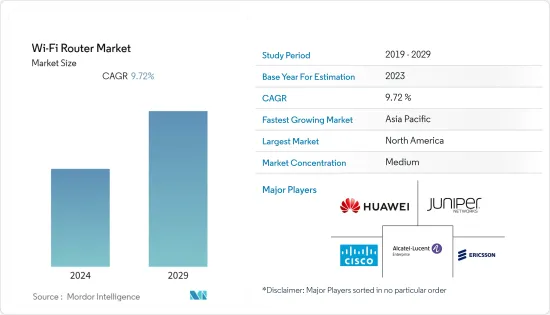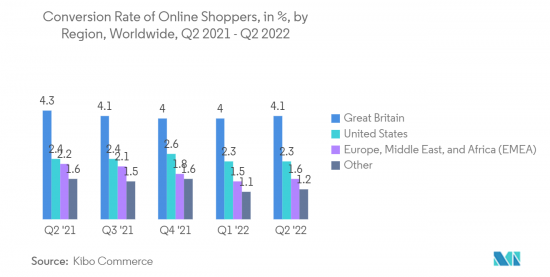|
|
市場調査レポート
商品コード
1408219
Wi-Fiルーター:市場シェア分析、産業動向・統計、2024~2029年成長予測Wi-Fi Router - Market Share Analysis, Industry Trends & Statistics, Growth Forecasts 2024 - 2029 |
||||||
カスタマイズ可能
適宜更新あり
|
|||||||
| Wi-Fiルーター:市場シェア分析、産業動向・統計、2024~2029年成長予測 |
|
出版日: 2024年01月04日
発行: Mordor Intelligence
ページ情報: 英文 120 Pages
納期: 2~3営業日
|
- 全表示
- 概要
- 目次
Wi-Fiルーターの世界市場規模は、現在のところ125億米ドルであり、予測期間中のCAGRは9.72%で、5年間で198億8,000万米ドルに達すると予測されています。
ウェブ閲覧、モバイル学習、その他のオンライン関連活動に従事する顧客が増加しており、より高速なインターネット・アクセスの需要が高まっています。その結果、ノートパソコン、PC、タブレットで頻繁に利用されるワイヤレスルーターは、人間の生存に不可欠なものとなっています。ワイヤレスルーターは、信頼できるインターネットに接続したいという消費者のニーズの高まりと、多くの国々におけるインターネット接続の強化に大きく貢献しています。

主なハイライト
- eコマース取引、ウェブ閲覧、モバイル学習、その他のオンライン関連活動に従事する顧客が増加しており、より高速なインターネットアクセスの需要が高まっています。その結果、ノートパソコン、PC、タブレットで頻繁に利用される無線ルーターは、人間の生存に不可欠なものとなっています。Wi-Fiルーターは、信頼できるインターネットに接続したいという消費者のニーズの高まりや、多くの国々でのWi-Fi接続の強化に大きく貢献しています。ヘルスケア、教育、ビジネス、金融サービス、その他の用途で接続デバイスの使用が増加していることは、世界の無線ルーター市場の重要な促進要因の1つです。さらに、中小企業がデバイス持ち込みポリシーを採用することも、市場成長にプラスの影響を与えています。さらに、予測期間中、スマートシティプロジェクトに対する政府の取り組みが増加し、市場拡大の好機が生まれると予測されています。
- さらに、国際通信連合(ITU)は、2022年には世界人口の66%にあたる53億人がインターネットを利用すると予測しています。これは2019年から24%の伸びを示し、その間に11億人がインターネットに参加すると予想されます。インターネットの普及が進めば、国内外のワイヤレスルーターベンダーが新製品を投入し、帯域幅を改善して大きな市場シェアを獲得する機会が生まれます。
- さらに、2023年までに、ネットワークに接続されたデバイスと接続数は、2018年の184億から300億近くになると、シスコのAnnual Internet Reportは予測しています。2023年までに、IoTデバイスはネットワーク接続デバイス全体の50%(147億)を占め、2018年の33%(61億)から増加します。さらにシスコによると、固定インターネットのIPトラフィックは、2016年の65,942台から2021年には1,87,386台に増加しています。このようなインターネットトラフィックの増加は、調査済み市場を牽引すると思われます。さらに統計カウンターによると、カナダでは2022年1月、モバイルトラフィックが全ウェブサイトトラフィックの38.04%以上を占め、2020年の40.95%から減少しました。カナダでは、デスクトップとラップトップが引き続きウェブ利用を支配しています。このようなインターネット接続デバイスの増加は、研究市場の成長を可能にすると思われます。
- 一方、ノキアの2022年年次モバイル・ブロードバンド・インデックス(MBiT)レポートによると、データ・トラフィックは31%増加し、モバイル・データ利用の月平均はユーザー1人当たり17GBに達しました。急速に拡大するインドの4Gおよび5Gネットワークは、実質的にすべてのモバイル・ブロードバンド・トラフィックを伝送しました。報告書によると、2021年には4,000万人以上の新規またはアップグレードされた4G加入者がサービスを利用することになります。デジタル化の適応が進めば、この量はさらに増えると思われます。都市圏のトラフィックは以前に比べて大幅に増加しています。近年、第4世代ロング・ターム・エボリューション(4G/LTE)モバイル・ブロードバンド・ネットワークによって、管轄区域間および分野間の通信相互運用性が大いに助けられました。
- 在宅勤務は、COVID流行後のメガ動向となった。大規模な遠隔勤務へのシフトのスピードは、携帯電話、ノートパソコン、デスクトップなどの個人用デバイスの使用をもたらしました。また、従業員が企業ネットワークにアクセスするために、個人用またはワイヤレスのWi-Fiルーターやインターネット接続を使用していることも確認されています。ユーロスタットによると、欧州では在宅勤務が可能な雇用者の割合が大幅に増加しており、フランスで29.4%、ドイツで22.8%、スペインで15.1%、イタリアで13.6%に達しています。
Wi-Fiルーター市場動向
小売とeコマースが市場で大きなシェアを占める見込み
- eコマース(電子商取引)とは、インターネット上で商品やサービスを売買すること。モバイル・ショッピングやオンライン決済の暗号化など、オンライン上の売り手と買い手のためのさまざまなデータ、システム、ツールが含まれます。オンライン・プレゼンスを持つほとんどの企業は、オンライン・ストアやプラットフォームを利用してeコマースのマーケティングや販売活動を行い、ロジスティクスやフルフィルメントを監督しています。このようなeコマースの動向は、消費者がどのオンライン・ショッピング・サイトにもアクセスできるよう、Wi-Fiルーターの需要を押し上げると思われます。
- eコマース取引、ウェブ・ブラウジング、モバイル学習、その他のオンライン関連活動に従事する顧客が増加しており、より高速なインターネット・アクセスの需要が高まっています。その結果、ノートパソコンやPC、タブレット端末で頻繁に利用される無線LANルーターは、人間の生存に不可欠なものとなった。Wi-Fiルーターは、信頼できるインターネットに接続したいという消費者のニーズの高まりや、多くの国々におけるWi-Fi接続の強化に大きく貢献しています。
- GSMA(Groupe Speciale Mobile Association)のインテリジェンス・データによると、2022年初頭、シンガポールのアクティブ・モバイル接続数は870万だった。さらに、シンガポールのモバイル接続は、2022年1月の総人口の147%に相当します。この地域におけるこのようなインターネットの普及は、eコマース市場を牽引すると思われます。さらに、シンガポール統計局によると、2022年、コンピューターと通信機器のオンライン販売は総販売額の47.4%を占める。これに対し、家具や家庭用機器の30%はオンラインで購入されています。この地域におけるオンライン購入のこのような増加は、新規プレーヤーが市場に参入する機会や、国際的プレーヤーがシンガポールでのプレゼンスを拡大する機会を大きく生み出すと思われます。
- 運輸通信省(MoTC)によると、カタールは1回の平均取引額が264米ドルで、中東諸国をリードしています。さらに、同国では昨年350社のeコマース企業が営業しており、今後6ヵ月でさらに66社のeコマース企業が開業し、昨年12月末までに416社に達しました。さらに、カタールにおけるeコマースの普及率は62.1%です。また、オンラインショッピングを利用する人を属性別にみると、カタール人(22%)が最も多く、次いで欧米人(17%)、アラブ人(19%)、アジア人(20%)、その他(22%)となっています。カタールは中東・北アフリカ(MENA)地域でユーザー1人当たりの年間eコマース平均利用額が最も大きく(GCCと比較)、オンライン取引1件当たりの平均利用額はGCC平均を上回っています。
- Kibo Commerceによると、2022年第2四半期、米国ではeコマース・ウェブサイトへの訪問のうち2.3%が購入に結びついた。英国では、オンラインショッパーのコンバージョン率は4%以上に上昇しました。モバイル・コマースは、ページビューと収益に関しては追い上げているもの、PCを介した従来のオンライン・ショッピングが依然としてトップを維持しています。このようなオンラインユーザーのコンバージョン率の上昇は、学生市場にプラスの影響を与えています。

北米が市場で大きなシェアを占める見込み
- 米国は、技術開発、ビジネスのデジタル化、インターネット利用の面で先進国のひとつです。高速インターネットの要件は、国のデジタル変革の旅の要件に一致するために不可欠になってきています。シスコシステムズによると、北米の平均Wi-Fiネットワーク接続速度は、2020年の70.7Mbpsから2023年には109.5Mbpsに増加します。このような巨大なスピードのインターネットは、そのようなインターネットスピードをサポートする新しいWi-Fiルーターを開発するようプレーヤーを後押しすると思われます。
- 米国政府は、米国の民間セクターと協力しながら、タイ4.0の支援に取り組んでいます。2022年、米国、タイ王国政府、企業幹部は、6GHz帯周波数割り当ての意義と次世代Wi-Fi技術に関する知識を共有するワークショップを開始しました。このワークショップは、家庭用Wi-Fiを高速化するだけでなく、高度製造業と産業革新の拠点としてのタイの地位をさらに強固なものにすると思われます。同国間のこうしたパートナーシップは、米国のWi-Fiメーカー市場を牽引すると思われます。
- この地域の企業は市場シェアを拡大するため、経済的な価格で最新の製品を発売しています。例えば、アメリカのルーターメーカーであるリンクシスは、2022年5月に、Hydra 6やAtlas 6などのデュアルバンドWi-Fi 6ルーターを発表する予定です。これらのルーターは、リーズナブルな価格でスピードとパフォーマンスを追求した設計であるため、ハイブリッドワーク、オンラインゲーム、4K UHDストリーミングなどに信頼性の高い接続性を提供すると思われます。
- カナダは経済的に発展しており、人々は便利なスマートデバイスを購入する余裕があります。シスコによると、2016年には6.3台だった国民1人当たりのデバイスと接続数は、2021年には10.7台に増加します。また、2023年までにカナダのインターネット・ユーザーは3,530万人になると予想されており、インターネット・ユーザーの増加はWi-Fiルーターにプラスの影響を与えるため、同国のWi-Fiルーターには大きな成長の可能性があります。
- 同国では、低遅延で高速なインターネット・サービスへのニーズが高まっており、多くの世界・プレーヤーが同国で先進的なWi-Fiルーターやメッシュ型Wi-Fiルーターを発売しています。例えば、グーグルは2022年10月、トライバンド・メッシュ・ネットワークで動作可能な同社初のルーター、Wi-Fi 6E対応のNest Wi-Fi Proをカナダで発売しました。対応機器では、混雑の少ない新しい6GHz無線帯域を使用するWi-Fi 6E(E for Extended)は、Wi-Fi 6の最大2倍の速度を提供します。
Wi-Fiルーター業界の概要
Wi-Fiルーター市場は、シスコシステムズ社、エリクソン社、ファーウェイ・テクノロジーズ社、ジュニパーネットワークス社、アルカテル・ルーセント・エンタープライズ社など複数の企業が存在し、適度に統合されています。各社は戦略的パートナーシップや製品開拓に継続的に投資し、市場シェアを大きく伸ばしています。
2023年3月、NETGEARは初のWi-Fi 7対応ルーターであるNighthawk RS700を発表しました。NETGEARは、このトライバンド・ユニットは低遅延のAR(拡張現実)/VR(仮想現実)ゲーム、UHDズーム通話、8K同時ストリーミング、その他多くのために設計されていると述べた。RS700は以前のNighthawkルーターを彷彿とさせない新しいタワーのような形状をしており、最大3,500平方フィートの360度カバーのためのアンテナを内蔵するよう設計されています。
2022年11月、世界のコンシューマー向けおよびビジネス向けネットワーク製品を提供するTP-Linkは、家庭向けおよびビジネス向けのWi-Fi 7製品ライン全体を発表しました。TP-Linkは新しいWi-Fi 7ルーター、Omada EAP、Deco製品、ISP市場向けのAginet製品を発売し、あらゆる利用シーンをカバーします。TP-Linkの新しいHomeShield 3.0も、より信頼性が高くスマートなネットワークソリューションを提供します。Archerシリーズの最高性能の1つとして継続するWi-Fi 7ルーターは、これまでにない体験を家庭にもたらします。今回のイベントでは、3種類のWi-Fi 7ルーターが発表されました。その中でもArcher BE900は、クワッドバンド24GbpsのWi-Fi 7速度を持ち、従来のルーターから一新された全く新しいデザインとなっています。
その他の特典:
- エクセル形式の市場予測(ME)シート
- 3ヶ月間のアナリスト・サポート
目次
第1章 イントロダクション
- 調査の前提条件と市場定義
- 調査範囲
第2章 調査手法
第3章 エグゼクティブサマリー
第4章 市場洞察
- 市場概要
- エコシステム分析
- 業界の魅力度-ポーターのファイブフォース分析
- 買い手の交渉力
- 供給企業の交渉力
- 新規参入業者の脅威
- 代替品の脅威
- 競争企業間の敵対関係の強さ
- COVID-19の市場への影響評価
- 使用事例
第5章 市場力学
- 市場促進要因
- インターネットトラフィックの増加とインターネット対応デバイスに対する消費者需要の増加
- デジタル化に伴う企業全体の帯域幅要件の急激な増加
- 市場抑制要因
- ネットワークセキュリティとネットワーク管理に関する複雑さ
- モバイルブロードバンドの利用
第6章 市場セグメンテーション
- タイプ別
- エッジルーター
- コアルーター
- 組織規模別
- 中小企業
- 大企業
- エンドユーザー業界別
- ヘルスケア
- 運輸・物流
- 小売・eコマース
- 製造業
- 政府機関
- BFSI
- その他
- 地域別
- 北米
- 欧州
- APAC
- 中東・アフリカ
- ラテンアメリカ
第7章 競合情勢
- 企業プロファイル
- Cisco Systems Inc
- Ericsson Inc.
- Huawei Technologies Co.ltd
- Juniper Networks Inc.
- Alcatel Lucent Enterprise SAS
- ARUBA S.P.A
- Fortinet Inc.
- Panasonic Corporation
- Broadcom Inc
- Extreme Networks Inc.
第8章 投資分析
第9章 今後の動向

The global Wi-Fi router market is valued at USD 12.50 billion in the current year and is expected to reach USD 19.88 billion over five years, achieving a CAGR of 9.72% during the forecast period. A growing number of customers are engaging in web browsing, mobile learning, and other online-related activities, driving the demand for faster Internet access. As a result, the wireless router, frequently utilized in laptops, PCs, and tablets, has become essential for human existence. Wireless routers are primarily responsible for the rising need among consumers to stay linked to dependable Internet and for enhancing internet connections in numerous nations.
Key Highlights
- A growing number of customers are engaging in e-commerce transactions, web browsing, mobile learning, and other online-related activities, driving the demand for faster Internet access. As a result, the wireless router, frequently utilized in laptops, PCs, and tablets, has become essential for human existence. Wi-Fi routers are mostly responsible for the rising need among consumers to stay linked to dependable Internet and for enhancing Wi-Fi connections in numerous nations. The increasing use of connected devices in healthcare, education, business, financial services, and other applications is one of the critical drivers of the worldwide wireless router market. Additionally, the market growth is positively impacted by small and medium businesses adopting a bring your device policy. Further, during the projected period, a rise in government initiatives for smart city projects is anticipated to create lucrative opportunities for market expansion.
- Further, in 2022, the International Telecommunication Union (ITU) estimates that 5,300 Million people, or 66% of the world's population, will use the Internet. This marks a 24% growth from 2019, with an expected 1.1 billion individuals joining the Internet throughout that time. The advancement in Internet penetration will create opportunities for international and local Wireless router vendors to introduce new products and improve the bandwidth to capture a significant market share.
- Moreover, By 2023, there will be close to 30 billion network-connected devices and connections, up from 18.4 billion in 2018, predicts Cisco's Annual Internet Report. By 2023, IoT devices will drive up 50% (14.7 billion) of all networked devices, up from 33% (6.1 billion) in 2018. Further, according to Cisco, the fixed internet IP traffic has increased from 65,942 units in 2016 to 1,87,386 units in 2021. Such a rise in internet traffic will drive the studied market. Further, according to the stats counter, in Canada, mobile traffic accounted for more than 38.04 % of all website traffic in January 2022, down from 40.95% in 2020. In Canada, desktops and laptops continue to dominate web usage. Such a rise in Internet-connected devices would allow the studied market to grow.
- On the flip side, According to Nokia's 2022 Annual Mobile Broadband Index (MBiT) Report, data traffic grew by 31%, and the monthly average for mobile data use reached 17GB per user. India's rapidly expanding 4G and 5G networks carried practically all mobile broadband traffic. More than 40 million new or upgraded 4G subscribers will be using services in 2021, according to the report. As digitization adaptation increases, this amount will increase even more. Traffic in metro areas has significantly increased as compared to prior years. In recent years, inter-jurisdictional and inter-disciplinary communications interoperability was greatly aided by the fourth generation Long Term Evolution (4G/LTE) mobile broadband networks.
- Working from home has become a megatrend post COVID pandemic. The speed of the shift to large-scale distant work has resulted in the use of personal devices, including portable phones, laptops, desktops, etc. Employees are also observed using individual or wireless Wi-Fi routers and internet connections to access the corporate network. According to Eurostat, a considerable increase in the proportion of employed people in Europe who could work from home was observed, reaching 29.4% in France, 22.8% in Germany, 15.1 percentage in Spain, and 13.6% in Italy.
Wi-Fi Router Market Trends
Retail and E-commerce are Expected to Hold Significant Share of the Market
- E-commerce (or electronic commerce) is the buying and selling of goods or services on the Internet. It encompasses various data, systems, and tools for online buyers and sellers, including mobile shopping and online payment encryption. Most businesses with an online presence use an online store and/or platform to conduct ecommerce marketing and sales activities and to oversee logistics and fulfillment. Such trends in E-commerce would drive the demand for Wi-Fi routers so that consumers can have access to any online shopping site.
- A growing number of customers are engaging in e-commerce transactions, web browsing, mobile learning, and other online-related activities, driving the demand for faster internet access. As a result, the wireless router, frequently utilized in laptops, PCs, and tablets, has become essential for human existence. Wi-Fi routers are mostly responsible for the rising need among consumers to stay linked to dependable Internet and for enhancing Wi-Fi connections in numerous nations.
- At the beginning of 2022, Singapore had 8.70 million active mobile connections, according to data from Groupe Speciale Mobile Association (GSMA) Intelligence. Furthermore, mobile connections in Singapore were equivalent to 147% of the total population in January 2022. Such internet penetration in the region will drive the e-commerce market. Furthermore, According to the Singapore Department of Statistics, in 2022, online computer and telecommunications equipment sales accounted for 47.4% of total sales. In comparison, 30% of furniture and household equipment were acquired online. Such a rise in online purchases in the region will significantly create an opportunity for new players to enter the market and for international players to expand their presence in Singapore.
- According to the Ministry of Transport and Communications (MoTC), Qatar leads the Middle Eastern countries in terms of the average value of a single transaction at USD 264 per transaction. Moreover, 350 e-commerce companies were operating in the country last year, and 66 more e-commerce companies opened in the next six months, bringing the total to 416 by the end of December last year. Further, in Qatar, e-commerce penetration is 62.1%. Also, online shoppers by demographics, Qataris (22%), are the most likely to shop online, followed by Westerners (17%), Arabs (19%), Asians (20%), and others (22%). Qatar has the most significant average yearly e-commerce spend per user in the Middle East and Northern Africa (MENA) area (relative to the GCC), and the average value per online transaction is greater than the GCC average.
- According to Kibo Commerce, During the second quarter of 2022, 2.3% of visits to e-commerce websites in the United States converted to purchases. In Great Britain, online shopper conversion rates rose to over four percent. Although mobile commerce is catching up regarding page views and revenue, traditional online shopping via PC still holds the top. Such a rise number of online users' conversion rates positively impact the student market.

North America is Expected to Hold Significant Share of the Market
- The United States is one of the leading countries in terms of technological development, digitalization of businesses, and internet usage. The requirement of high-speed internet is becoming essential to match the requirement for the country's digital transformation journey. According to Cisco Systems, the average Wi-Fi network connection speed in North America was 109.5 Mbps in 2023, an increase from 70.7 Mbps in 2020. Such huge speed internet would push the players to develop new Wi-Fi routers to support such internet speeds.
- The United States government is engaged in assisting Thailand 4.0., as they were collaborating with America's private sectors. In 2022, the United States, the Royal Thai government, and business executives started a workshop to share knowledge on the significance of 6 GHz spectrum allocation and next-generation Wi-Fi technology, which will not only make home Wi-Fi faster but also further solidify Thailand's position as a hub of advanced manufacturing and industry innovation. These partnerships between the country will drive the market for Wi-Fi manufacturers in the USA.
- Companies in the region are launching updated products with economical prices to increase their market shares. For example, in May 2022, American router maker Linksys intends to introduce dual-band Wi-Fi 6 routers, including the Hydra 6 and Atlas 6. These routers would offer reliable connectivity for hybrid work, online gaming, 4K UHD streaming, and more because they are designed for speed and performance at a reasonable price.
- Canada is an economically developed country for which people can afford smart devices for their convenience, and the number of connected devices has been increasing in the country, fueled by internet penetration. According to Cisco, Devices and connection per capita increased to 10.7 in 2021, which was 6.3 in 2016. In addition, by 2023, there will be 35.3 million Internet users in Canada, which shows huge growth potential for the Wi-Fi routers in the country because the growth of Internet users will positively impact the Wi-Fi routers.
- The country's need for Internet services with low latency and increasing speed is increasing, and many global players are launching advanced Wi-Fi routers or meshed Wi-Fi routers in the country. For example, in October 2022, Google launched its Nest Wi-Fi Pro with Wi-Fi 6E support in Canada, the company's first router capable of operating in a triband mesh network. On compatible devices, Wi-Fi 6E (E for Extended), which uses the new, less-congested 6 GHz radio band, provides speeds up to two times quicker than Wi-Fi 6.
Wi-Fi Router Industry Overview
The Wi-Fi router market is moderately consolidated with the presence of several players like Cisco Systems Inc, Ericsson Inc., Huawei Technologies Co. Ltd., Juniper Networks Inc., Alcatel Lucent Enterprise, etc. The companies continuously invest in strategic partnerships and product developments to gain substantial market share.
In March 2023, NETGEAR introduced its first Wi-Fi 7-capable router, the Nighthawk RS700 - possibly one of the fastest consumer-grade networking devices capable of a 19 Gbps peak data rate. NETGEAR stated the tri-band unit is designed for low-latency AR(Augmented Reality)/VR (Virtual reality) gaming, UHD Zoom calls, 8k simultaneous streaming, and many more. The RS700 has a new tower-like shape not reminiscent of the last Nighthawk routers, which is designed to house antennas for 360-degree coverage of up to 3,500 square feet.
In November 2022, TP-Link, a global consumer and business networking product provider, released an entire home and business Wi-Fi 7 product line. TP-Link launched new Wi-Fi 7 routers, Omada EAPs, Deco products, and Aginet products for ISP markets to cover all usage scenarios. TP-Link's new HomeShield 3.0 also provides more reliable and smarter network solutions. Continuing as one of the top performances of the Archer series, Wi-Fi 7 routers bring unprecedented experiences to homes. Three Wi-Fi 7 routers were unveiled at the event. Among them, Archer BE900 has quad-band 24 Gbps Wi-Fi 7 speeds and has a brand new design reimagined from previous routers.
Additional Benefits:
- The market estimate (ME) sheet in Excel format
- 3 months of analyst support
TABLE OF CONTENTS
1 INTRODUCTION
- 1.1 Study Assumptions and Market Definition
- 1.2 Scope of the Study
2 RESEARCH METHODOLOGY
3 EXECUTIVE SUMMARY
4 MARKET INSIGHTS
- 4.1 Market Overview
- 4.2 Industry Ecosystem Analysis
- 4.3 Industry Attractiveness - Porter's Five Forces Analysis
- 4.3.1 Bargaining Power of Buyers
- 4.3.2 Bargaining Power of Suppliers
- 4.3.3 Threat of New Entrants
- 4.3.4 Threat of Substitutes
- 4.3.5 Intensity of Competitive Rivalry
- 4.4 Assessment of the Impact of COVID-19 on the Market
- 4.5 Use Cases
5 MARKET DYNAMICS
- 5.1 Market Drivers
- 5.1.1 Growth in Internet Traffic and Increasing Consumer Demand for Internet-enabled Devices
- 5.1.2 Exponential Increase in the Bandwidth Requirements across Enterprises owing to Digitization
- 5.2 Market Restraints
- 5.2.1 Network Security and Complexities Related to Network Management
- 5.2.2 Usage of Mobile Broadband
6 MARKET SEGMENTATION
- 6.1 By Type
- 6.1.1 Edge Router
- 6.1.2 Core Router
- 6.2 By Organization Size
- 6.2.1 SMEs
- 6.2.2 Large Enterprises
- 6.3 By End-User Industry
- 6.3.1 Healthcare
- 6.3.2 Transportation & Logistics
- 6.3.3 Retail & eCommerce
- 6.3.4 Manufacturing
- 6.3.5 Government
- 6.3.6 BFSI
- 6.3.7 Others
- 6.4 By Geography
- 6.4.1 North America
- 6.4.2 Europe
- 6.4.3 APAC
- 6.4.4 Middle East and Africa
- 6.4.5 Latin America
7 COMPETITIVE LANDSCAPE
- 7.1 Company Profiles
- 7.1.1 Cisco Systems Inc
- 7.1.2 Ericsson Inc.
- 7.1.3 Huawei Technologies Co.ltd
- 7.1.4 Juniper Networks Inc.
- 7.1.5 Alcatel Lucent Enterprise SAS
- 7.1.6 ARUBA S.P.A
- 7.1.7 Fortinet Inc.
- 7.1.8 Panasonic Corporation
- 7.1.9 Broadcom Inc
- 7.1.10 Extreme Networks Inc.





